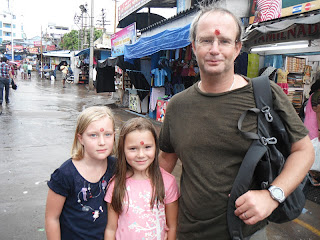So, here we are in Kanyakumari - also sometimes referred to as Cape Comorin and located at the southernmost tip of the Indian Peninsula, the geographical end of the Indian mainland and the confluence of three water-bodies – the Arabian Sea, the Bay of Bengal and the Indian Ocean. We spend the day dipping in and out of the rain - but manage to visit the main sites of interest - all the while dodging the bus loads of Indian pilgrims making their way to worship at the The Kumari Amman or the Kanyakumari Temple after which the town is named.
We begin our walkabout with a hunt for a working cashpoint and end up, very definitely, on the wrong side of town. We get our first taste and glimpse of apparant absolute poverty as we pass by several little groups of gaunt looking women coupled with small children, some naked, some in rags. The older children run alongside us, pawing at our arms and hold out cupped hands or little metal dishes. It is the hardest thing ever to walk on without even an acknowledgement and we turn a corner and have a "team hug" out of sight. Working ATM located we now have to find our way back and, so as to avoid the begging children (whom tourists are asked not to encourage but to instead donate to exisiting charity projects) we take a side turning in the general direction of the sea and hope that we will eventually find our way back. We are amazed at the size of this rat which thankfully was already dead when we pass by!
It is an interesting route back through the less well travelled side and back streets and straight though the middle of a very basic housing area belonging to the local fishing village. The water here though is foul, black, laden with oil and rubbish. and most astonishingly several enormous and very prominent white catholic churches.


We shelter in the doorway of one church on the shoreline while another rainstorm passes and look out towards the two most prominent manmade features of Kanyakumari sited on two rocky islets just off the shore. The rock where Swami Vivekananda is said to have meditated for three days is now home to a memorial building built in 1970. On the smaller island there is a huge statue of Tamil saint-poet Thiruvalluvar and one of the biggest statues in Asia. At a gigantic 133 feet (41 m) tall to reflect his famous 133 chapter poem "Thirukal" - erected in 2000 and the work of more than 5000 sculptors. One of the rocks called Sri Padhaparai is said to bear the footprints of a virgin goddess.



On the shoreline is the bright pink Gandhi Memorial has been built on the spot where the urn containing the Mahatma's ashes was kept for public viewing before immersion. Resembling central Indian Hindu temples in form, the memorial was designed in such a way that on Mahatma Gandhi's birthday, 2 October, the first rays of the sun fall on the exact place where his ashes were kept.
The Kumari Amman temple, situated overlooking the shore, attract tourists from all over the world. Legend says that the virgin goddess Kumari single handedly conquered demons and secured the freedom of the world. The sparkling diamond nose-ring of the deity is said to be visible even from the sea. David (as all men do) has to remove his shirt to enter as is customary to do at a temple dedicated to goddesses, and we were not allowed to take our shoes or camera inside. We are escorted, at break neck speed, by a temple worker and shown the main sections - including the beautifully ornate goddess image covered in sparkly jewels and receive our sandalwood mark from the priest.

The adjoining ghat and beach is full of hindu pilgrims bathing in the crashing waves of three oceans, and we stand in the rain and watch them for a while.
As we walk back to the hotel dodging the rain we catch sight of these locals taking advantage of the downpour in the runoff from the rooves.








No comments:
Post a Comment